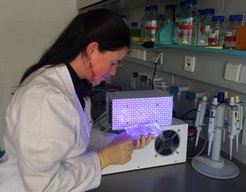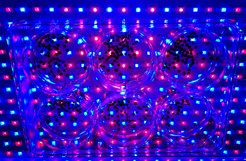New research group for light-controlled organization of cell-like compartments
Since January 1, 2016 Dr. Seraphine Wegner leads a new research group at the Max Planck Institute for Polymer Research. She will use light to control the organization of synthetic compartments and cells.

Mainz. Wegner has been granted 1.4 million euros by the German Federal Ministry of Education and Research (BMBF) for her MaxSynBio Junior research group over the next five years. Her group, which is part of the MaxSynBio network, aims to control the organization of cells and cell-like compartments with light.
The independent MaxSynBio research group headed by Wegner combines two disciplines: synthetic biology and optogenetics. Synthetic biology not only aims at controlling biological matter but also at building it. This is exactly what the group plans to do: Using a bottom-up approach, they will try to reproduce the dynamic, yet regulated, organization of cells that exists in nature with synthetic cell-like compartments in which various life processes take place. Their aim is to control the self-organization of molecular building blocks and cell-like compartments with light, which provides high spatial and temporal precision. Towards this end plant proteins that respond to visible light and are widely used in optogenetics will be used. Optogenetics is a combination of genetic and optical methods to achieve fast control of precisely defined events with light in biological systems. Visible light presents a few advantages: it enables high spatial and temporal control, is non-invasive and bio-orthogonal, i.e. the chemical reactions that occur inside the cell do not interfere with native biochemical processes.

Another focus of the group is to control cell contacts with light. In multicellular organisms cells interact with neighboring cells and the extracellular matrix (ECM) to form cell-cell and cell-matrix contacts. The cell then assimilates all signals to respond appropriately to its environment and triggers responses, such as adhesion, migration, proliferation or self-destruction. The group aims to control cell-matrix and cell-cell interactions photochemically, using light sensitive molecules. This will help to study not only intercellular processes, for example collective cell migration and differentiation, but also intracellular processes, such as local cell-cell contact dynamics. “We hope to afford valuable insight into interactions between cells and synthetic surfaces and to apply these results to the development of new bio-instructive materials,” says Wegner.
About the project:
Wegner’s research group is part of the Max Planck Research Network in Synthetic Biology called MaxSynBio. The network involves research groups from nine Max Planck Institutes across Germany, as well as the Department of Theology of the Friedrich Alexander University Erlangen-Nuremberg. They try to identify the absolutely essential building blocks required to make a cell viable and to construct minimal cells also called protocells. They bring about great expectations in the biological and biotechnological production of biofuels, biomaterials or active principles for the medicine to name just a few.
About Seraphine Wegner:
Seraphine Wegner is head of the MaxSynBio group at the Max Planck Institute for Polymer Research. In 2011 she did a postdoc at the Max Planck Institute for Intelligent Systems in Stuttgart, Germany where she developed various surface functionalization and protein immobilization techniques to study cell-material interactions. Born in Düsseldorf, Germany, she spent many years abroad. Wegner lived in Turkey for 15 years before moving to the USA. There she completed her PhD in chemistry at the University of Chicago and worked on the development of metal ion sensors for in vivo imaging using metalloregulatory proteins.

